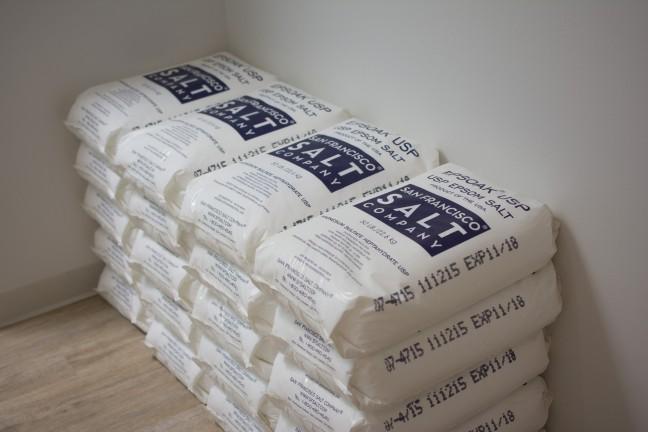In an effort to combat pollution in Madison lakes, the City of Madison Streets Division is attempting to limit road salt use due to its negative environmental and economic effects.
According to Wisconsin Saltwise, an organization designed to educate Dane County residents and maintenance professionals about road salt safety, it takes one teaspoon of salt to permanently pollute five gallons of water to a level that is toxic for freshwater ecosystems.
With snowy forecasts predicted throughout the winter months, road salt is a necessary tool in order to keep the roads driveable. But, the salt can wash into the lakes when met with rain and eventually cause harmful effects, according to Wisconsin Saltwise.
“We put about 500 tons [of salt] a year into Lake Mendota in an average winter,” Hilary Dugan, a University of Wisconsin professor and limnologist, told Fox 47. “It’s gone from a background concentration of 1 mg of salt per liter to about 50, so it’s about 50 times higher than it was back in the 1940s.”
Not only does salt degrade ecosystems in the lakes, but it is also costly to remove. Removing salt requires reverse osmosis treatments or ion exchange that can cost millions of dollars, according to Wisconsin Saltwise. The website also states the quality of drinking water will diminish if salt concentrations continue to exceed in lakes. As salt concentration increases in lakes, drinking water will begin to taste saltier as well.
According to Public Information Officer and Recycling Coordinator of the Streets Division Bryan Johnson, the Streets Division is very strategic about where salt is placed on the roads to limit their amount of salt use. Rather than salting every road in Madison, Johnson said the Street Division only maintains specific “salt routes” such as Metro bus routes and streets surrounding schools and hospitals.
“The maximum amount of salt we put down on the road is 300 pounds per lane mile,” Johnson said. “This is the industry standard for roads like ours. We can, and do, apply less than 300 pounds per lane mile if conditions require it, too. It takes a lot of careful watching of the weather, the pavement and understanding how those factors and more all play into how the roads will respond to our treatment.”
UW mediates student complaints, negative ecological effects of sidewalk salt
There are a multitude of factors which affect the way the streets are salted. Johnson said salt is not applied at all when temperatures are below 20 degrees because it is not effective at those temperatures. Additionally, calcium-chloride and magnesium-chloride are avoided in order to prevent chlorides in water.
Pre-treating streets with brine is another practice the Streets Division utilizes in order to prevent heavy salt usage. A saltwater brine composed of 23.3% salt is applied first, which prevents snow from bonding to the pavement. The brine allows crews to scrape snow off with plows and prevent future road salting, according to Johnson.
“[There are] other small things we do, too,” Johnson said. “Our salt trucks are equipped with saddle tanks full of brine, too. Before the salt is spread by the trucks, they spray the salt with a little bit of the brine. This helps because wet salt won’t bounce as much, and it will stay in the traffic lane.”
Less salt is used if it doesn’t spread, Johnson said.
Another way Madison is attempting to limit its salt usage is through a salt certification program in partnership with Wisconsin Saltwise. The program, which serves to educate winter maintenance professionals in the Dane County area about the environmental and economic impacts of oversalting, is voluntary for any crew members or contractors who wish to receive the training, according to City of Madison Water Resources Engineer Phil Gaebler.
Local law enforcement and pharmacies partner with local agencies, dispose of pharmaceuticals
The salt certification program involves a six hour training session as well as a quiz afterward. If one received a score of 70% or better on the quiz, they achieve the certification, according to Gaebler. There are two separate trainings — one for those who maintain parking lots, sidewalks and trails, and one for those who maintain roads with snowplows.
Gaebler said those who implement their training reduce their salt use.
“One example we have is in our parks department, which maintains State Street,” Gaebler said. “Just by making some very small and inexpensive upgrades to equipment, calibrating the equipment and taking their application rate based on the weather, they had about a 40% reduction of salt.”
According to Linnea Rock, a limnologist at the UW Center for Limnology, a good rule of thumb for personal salt use is a 12 oz. cup of salt is sufficient for 10 sidewalk blocks. Rock also recommends the salt should be scattered in pieces with several inches in between.
Rock said once the salt is dissolved in the water, it cannot be removed. Therefore, one must be conscious of their salt use in order for it to maintain its effectiveness.
“In Madison, road salt has been used for about six decades, which means there is already a lot of salt stored up in the ground and in our water,” Rock said. “Even if we discontinued using road salt completely, it could take many more decades for the buildup of salt to leave this system.”





















